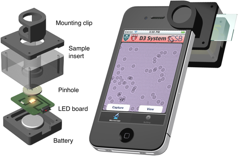POINT-OF-CARE DIAGNOSTIC SYSTEMS
We are committed to develop robust, easy-to-use diagnostic tools, with applications in resource-limited settings. Some of the developed systems include a smartphone-based imaging system for point-of-care cancer detection, a fluorescence-polarization device to diagnose infection, and a magneto-electrochemical sensor for food-safety. We envision that these efforts will create new opportunities for inexpensive point-of-care diagnostics and prompt care delivery, addressing global health problems and bringing forth societal benefits.
Smartphone-based diagnostics
Smartphone molecular diagnostics.By attaching a small light module (left) to the phone camera, we transformed a smartphone into a molecular imaging tool. The system was used to profile individual cells for protein expression.
The widespread distribution of smartphones, with their integrated sensors and communication capabilities, makes them an ideal platform for point-of-care diagnosis, especially in resource-limited settings. We are developing new approaches to enable molecular diagnostics on smartphones. In one method, we used molecular-specific microbeads to generate unique diffraction patterns which can be recorded and de-convoluted by digital processing. We applied the system to resolve individual pre-cancerous and cancerous cells as well as to detect cancer-associated
DNA targets. Because the system is compact, easy to operate and readily integrates with standard, portable smartphones, this approach could enable medical diagnostics in geographically and/or socioeconomically limited settings with pathology bottlenecks.
Polarization anisotropy detection (PAD)
PAD detection. (Left) Samples containing nucleic acids are mixed with a dual probe set. In the presence of target nucleic acid sequence, the DNA polymerase becomes inactive, and fluorescence polarization signal is high. (Right) A portable PAD device was implemented.
The
PAD (polarization anisotropy detection) is a new, cost-effective readout technology to detect nucleic-acids (NAs). The key innovation is the molecular probes which report different fluorescence anisotropy in the presence of target nucleic acids. This strategy makes the assay simple and straightforward, since all reactions take place in the same tube without requiring washing steps. The measurement, for its ratiometric nature, is robust against noise (e.g., temperature, light fluctuation), and can be performed with simple optics. To facilitate on-site
PAD assays, we have implemented a portable detector with a smartphone interface. The developed system has been used to detect healthcare-associated infections (HAIs) in patient samples.

